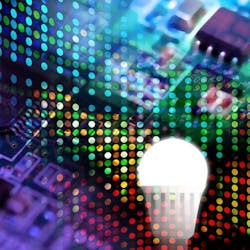The Digital Illumination Interface Alliance (DiiA) and the Zhaga Consortium demonstrated multivendor interoperability of the new D4i intra-luminaire interconnect at the LED professional Symposium (LpS) in Bregenz, Austria. The solid-state lighting (SSL)-centric DesignLights Consortium (DLC) has added two experienced professionals to its staff. The Zigbee Alliance has added the Dekra test laboratory in Málaga, Spain as an accredited partner for interoperability testing of products based on the Zigbee standards. Meanwhile, SSL manufacturers have access to a new calibration lab from NIST (National Institute of Standards and Technology) with better accuracy and faster test times.
D4i
As we covered in a recent feature article, D4i is a standard endorsed both by the DiiA and Zhaga for communications internal to an LED-based luminaire — say, between an LED driver, a module that integrates sensors, a controller, and external or inter-luminaire connectivity. D4i is based on DALI-2 (digital addressable lighting interface), which is primarily used in inter-luminaire applications. But D4i is intended for the inside job and adds the provision for an LED driver to power a connectivity module over the same bus through which data travels.
At LpS, Zhaga demonstrated street lights from multiple vendors in its booth that included communication modules, drivers, and sensor modules from multiple companies including Legrand, Osram, Schréder, Signify, TE Connectivity, and BJB. The luminaire products utilize the Zhaga Book 18 specification for adding a sensing/communication module to an outdoor SSL product.
DLC staff
Moving to the DLC organization, Leora Radetsky, previously of the Lighting Research Center (LRC) at Rensselaer Polytechnic Institute, and Dorene Maniccia, previously of Signify, are joining the staff. Maniccia is now director of strategic market development at the DLC. And Radetsky is a senior lighting scientist.
The DLC is a market transformation program whose qualified products lists often gate rebates and incentives offered by utilities and other institutions for energy-saving SSL projects. For example, some of the DLC’s latest work is on horticultural lighting products and the first such listings came back in March of this year.
Indeed, Radetsky has deep experience in horticultural lighting, garnered while working as a researcher at the LRC. Radetsky will also speak at our upcoming HortiCann Light+Tech conference that will take place Oct. 31 in Denver, CO.
“I am excited to join the DLC team and support its mission to drive energy-efficient, high-quality lighting to serve a diverse group of stakeholders, including manufacturers, regulators, energy efficiency organizations, lighting practitioners, and growers,” said Radetsky.
“Dorene Maniccia is a lighting industry trailblazer whose experience in market research and strategic planning, consensus building, stakeholder management, and team leadership is complemented by deep knowledge of lighting and controls design and application, as well as expertise in smart, sustainable buildings,” said DLC executive director Christina Halfpenny. “Leora Radetsky is a seasoned research scientist with over 20 years of experience in research and leadership roles, including product testing and evaluation, energy efficiency, lighting controls, and human factors research. We are extremely fortunate to have the diverse expertise they each bring to the DLC.”
Zigbee and Dekra
Moving to smart lighting and the Internet of Things (IoT), the options for wireless connectivity in SSL products continues to grow. Zigbee was one of the first such options on the market and the Zigbee Alliance has created a very large ecosystem around the standards including testing laboratories. Most recently, the alliance added the Dekra lab in Spain for interoperability certification testing.
“OEMs are facing new challenges due to the integration of multiple wireless technologies into their products — so certifying against leading well-defined standards, such as those from the Zigbee Alliance, helps manufacturers make and market their devices in a more efficient manner as streamlined, simplified technology translates to reduction in cost, complexities, and a faster time to market,” said Noemí Pérez, IoT laboratory manager at Dekra.
“Dekra is continuously enlarging the IoT service portfolio and footprints around the world,” added Thomas Jaeger, senior vice president and head of technology technical service management at Dekra. “We are excited to be part of the Zigbee ecosystem and we will definitely help to develop additional values.”
NIST lab
The new NIST lab is focused on measuring the brightness of LED lamps and luminaires, and more specifically on calibrating the performance of customers’ photometric instruments so that SSL developers can be confident in the measurements they make in their own laboratories. NIST says the new lab offers faster calibration times and more accuracy — reducing uncertainties to 0.2% or less, whereas some commercial services have uncertainties in the 0.5–1% range.
NIST said its old lab often required a full day to perform a calibration for a customer. The issue was in part logistics as each measurement required significant setup, such as swapping out light sources and measurement equipment. The new lab has two automated equipment tables and a rail system to position devices.
“I don’t have to change any of the equipment anymore. Everything’s right here — all the instruments are in line, ready to be used,” said NIST researcher Cameron Miller. “It gives us a lot of freedom to do many things at the same time, because it’s completely automated. We could be back in our office doing other work while it’s running.”





